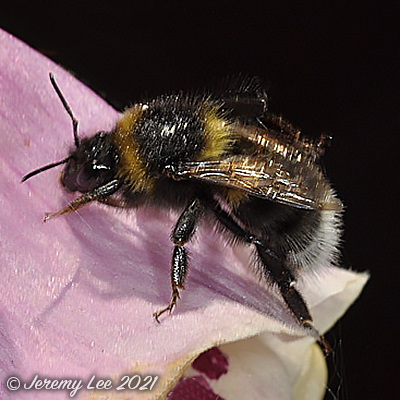
 |
|
Scientific Classifications explained » Amphibians » Ants » Aphids » Bees » Beetles » Birds » Bugs » Butterflies » Caterpillars » Damselflies » Dragonflies » Earwigs » Flies » Frog/Leafhoppers » Fungi » Galls » Grasshoppers » Harvestmen » Hoverflies » Lacewings » Ladybirds » Leaf Mines » Lichens » Mammals » Millipedes » Mosses » Moths » Sawflies » Slugs » Snails » Spiders » Trees & Shrubs » Wasps » Wild Flowers » Woodlice » Postboxes |
UK Nature > Bees > Bombus hortorum

Scientific Name: Bombus hortorum Common Name: Garden Bumblebee Bombus hortorum, more commonly known as the Garden Bumblebee, is a relatively large bee; queen 17-20 mm, workers 11-16 mm, male 14-15 mm. It has a long head and a slimmer body than some other Bombus species. The collar, scutellum and 1st abdominal segment are yellow, the tail is white. A rather scruffy looking long haired species. Pollen basket with black hair. Often seen in gardens as well as woodland edge and scrub areas, Bombus hortorum prefers flowers such as Red Clover, Cowslips, Foxglove, Vetches and Lavender. They are on the wing from late April to early October. Colonies contain between 50 and 120 bees, and are present between late April and early October. The queen, the only colony member to survive the winter emerges in April and begins to search for a suitable place in which to establish a nest. Nests are made underground, in banks and among tree roots, but nests in bird boxes have been known. One of the commonest and most widespread of bumblebees in Britain. |
|

https://www.uknature.co.uk is a website dedicated to showing the immense diversity of UK nature and wildlife. Our vast range of habitats, from lowland arable to snow covered mountains, from storm-ravaged coastlines to peaceful inland freshwater lakes and rivers, from dry, sandy heaths to deciduous and coniferous forests, all these habitats contribute to the abundance of UK nature. We have wild birds in huge numbers either residing or visiting our shores (597 recorded species as at July 2013) and we must also not forget the humble back garden with its grass lawns, flower beds filled with nectar rich flowers, shrubs and trees, all designed to attract huge numbers of insects such as bees, moths, butterflies and hoverflies; and finally the small ponds which provide safe havens for frogs, toads, newts and even slow worms and grass snakes. www.uknature.co.uk is the showcase for my personal passion, photographing uknature in all its glory. I sincerely hope you all enjoy the fruits of my labours. This site and all images contained therein is © Jeremy Lee 2004 - 2025. All Rights Reserved. Site design by Jeremy Lee. Site development & IT Support by Stuart Lee. |